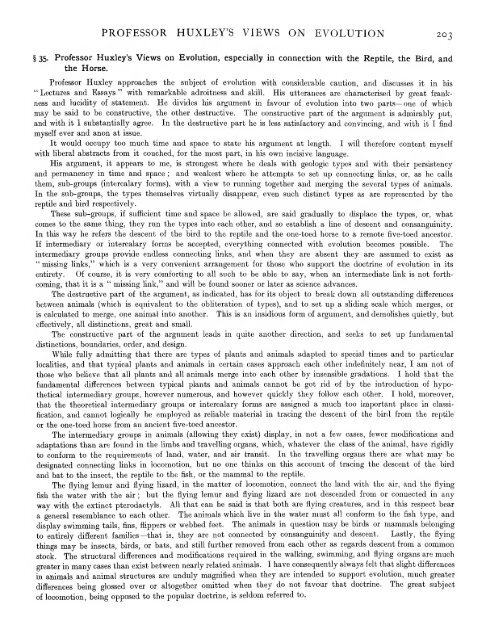Create successful ePaper yourself
Turn your PDF publications into a flip-book with our unique Google optimized e-Paper software.
PROFESSOR HUXLEY'S VIEWS ON EVOLUTION 203<br />
§ 35. Professor Huxley's Views on Evolution, especially in connection with the Reptile, the Bird, and<br />
the Horse.<br />
Professor Huxley approaches the subject of evolution with considerable caution, and discusses it in his<br />
"Lectures and Essays" with remarkable adroitness and skill. His utterances are characterised by great frank-<br />
ness and lucidity of statement. He divides his argument in favour of evolution into two parts— one of which<br />
may be said to be constructive, the other destructive. The constructive part of the argument is admirably put,<br />
and with it I substantially agree. In the destructive part he is less satisfactory and convincing, and with it I find<br />
myself ever and anon at issue.<br />
It would occupy too much time and space to state his argument at length. I will therefore content myself<br />
with liberal abstracts from it couched, for the most part, in his own incisive language.<br />
His argument, it appears to me, is strongest where he deals with geologic types and with their persistency<br />
and permanency in time and space ; and weakest where he attempts to set up connecting links, or, as he calls<br />
them, sub-groups (intercalary forms), with a view to running together and merging the several types of animals.<br />
In the sub-groups, the types themselves virtually disappear, even such distinct types as are represented by the<br />
reptile and bird respectively.<br />
These sub-groups, if sufficient time and space be allowed, are said gradually to displace the types, or, what<br />
comes to the same thing, they run the types into each other, and so establish a line of descent and consanguinity.<br />
In this way he refers the descent of the bird to the reptile and the one-toed horse to a remote five-toed ancestor.<br />
If intermediary or intercalary forms be accepted, everything connected with evolution becomes possible. The<br />
intermediary groups provide endless connecting links, and when they are absent they are assumed to exist as<br />
" missing links," which is a very convenient arrangement for those who support the doctrine of evolution in its<br />
entirety. Of course, it is very comforting to all such to be able to say, when an intermediate hnk is not forth-<br />
coming, that it is a " missing hnk," and will be found sooner or later as science advances.<br />
The destructive part of the argument, as indicated, has for its object to break down all outstanding differences<br />
between animals (which is equivalent to the obliteration of types), and to set up a shding scale which merges, or<br />
is calculated to merge, one animal into another. This is an insidious form of argument, and demolishes quietly, but<br />
effectively, all distinctions, great and small.<br />
The constructive part of the argument leads in quite another direction, and seeks to set up fundamental<br />
distinctions, boundaries, order, and design.<br />
While fully admitting that there are types of plants and animals adapted to special times and to particular<br />
locahties, and that typical plants and animals in certain cases approach each other indefinitely near, I am not of<br />
those who believe that all plants and all animals merge into each other by insensible gradations. I hold that the<br />
fundamental differences between typical plants and animals cannot be got rid of by the introduction of hypo-<br />
thetical intermediary groups, however numerous, and however quickly they follow each other. I hold, moreover,<br />
that the theoretical intermediary groups or intercalary forms are assigned a much too important place in classi-<br />
fication, and cannot logically be employed as reliable material in tracing the descent of the bird from the reptile<br />
or the one-toed horse from an ancient five-toed ancestor.<br />
The intermediary groups in animals (allowing they exist) display, in not a few cases, fewer modifications and<br />
adaptations than are found in the limbs and traveUing organs, which, whatever the class of the animal, have rigidly<br />
to conform to the requirements of land, water, and air transit. In the travelling organs there are what may be<br />
designated connecting finks in locomotion, but no one thinks on this account of tracing the descent of the bird<br />
and bat to the insect, the reptile to the fish, or the mammal to the reptile.<br />
The flying lemur and flying lizard, in the matter of locomotion, connect the land with the air, and the flying<br />
fish the water with the air ; but the flying lemur and flying hzard are not descended from or connected in any<br />
way with the extinct pterodactyls. All that can be said is that both are flying creatures, and in this respect bear<br />
a general resemblance to each other. The animals which live in the water must all conform to the fish type, and<br />
display swimming tails, fins, flippers or webbed feet. The animals in question may be birds or mammals belonging<br />
to entirely different families—that is, they are not connected by consanguinity and descent. Lastly, the flying<br />
things may be insects, birds, or bats, and still further removed from each other as regards descent from a common<br />
stock. The structural differences and modifications required in the walking, swimming, and flying organs are much<br />
greater in many cases than exist between nearly related animals. I have consequently always felt that slight differences<br />
in animals and animal structures are unduly magnified when they are intended to support evolution, much greater<br />
differences being glossed over or altogether omitted when they do not favour that doctrine. The great subject<br />
of locomotion, being opposed to the popular doctrine, is seldom referred to.


